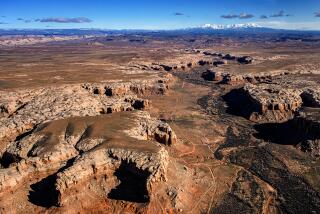Northeast Seeking to Balance Wilderness and Development
- Share via
CONCORD, N.H. — With the annual turning of the leaves as a backdrop, Northeasterners are coming to grips with pressures for development in the largest remaining wilderness in their area.
The desire to preserve the Northern Forest has led to the formation of an unusual coalition in a 13-member lands council. The Concord, N.H.-based group was formed with congressional authorization and includes government officials and environmental and industry representatives.
BACKGROUND: The Northern Forest is a 26-million-acre region recently defined by federal officials. The land of spruce-fir and northern hardwood and pristine mountains, rivers and lakes stretches across northern Maine, New Hampshire, Vermont and New York and is the most accessible recreational wilderness area for 70 million people.
The land, mostly privately owned, is also the source of livelihood for about 125,000 residents who work in timber and related industries.
Charles A. Levesque, the Northern Forest Lands Council’s director, said that concerns about the forest’s future first surfaced in the mid-1980s. Fueled by the economic boom of the era and improved transportation to the once-isolated region, demand for vacation homes soared. As a result, landowners came under pressure to sell to developers, who offered prices well above the value of the land when used for forestry purposes. Many did sell.
Alarm over the trend erupted in 1988, when investors acquired over a million acres of timberland as part of a hostile takeover of Diamond International Corp., and some of the land was sold to developers, Levesque said.
Although much of the Diamond land was saved through purchases by several states, the experience led Congress in 1988 to fund a study by the Forest Service into the future of the Northern Forest lands. The study, in turn, was used by a four-state governors’ task force that recommended formation of the council.
Levesque said a wide range of proposals has been offered to save the forest lands--from public acquisition of land, favored by some environmentalists, to providing tax breaks to landowners, favored by industry.
Jennifer Melville, conservation director for the Appalachian Mountain Club, said that environmental groups, despite their opposition to some timber practices, believe there is a role for woodcutting in the forests.
“The broad goal of the council is to maintain the long-term ecological and economic integrity of the region, not to put everyone out of a job,” she said.
And those in the forest products industry said they share many of the goals of environmentalists.
“We are very interested in maintaining Maine’s unique heritage and culture of having vast tracts of forest land available for both timber production and public use,” said Edward I. Johnston, executive director of the Maine Forest Products Council.
Also taking an interest in the forest lands council are tourist operators, who note the importance of the forests in luring visitors to the region, particularly when the leaves turn colors.
Richard Hamilton, president of the White Mountains Assn., a tourist promotion group, said he will support the council, but only if it avoids massive public land acquisitions, which he said could limit access of visitors to wilderness areas.
THE OUTLOOK: John D. Harrigan, a council member from New Hampshire, said the real threat to the public’s future enjoyment of the forests would be inaction now.
“Everyone wants a piece of God’s country. We live in God’s country and we take it for granted,” he said.
However, the council faces an uncertain future; its mission has come under fire, primarily from groups working on behalf of small landholders, who oppose what they see as federal intrusion.
“It’s a fragile but very important effort to see if what has been very disparate interests with regard to the forest . . . can come to some shared vision,” said Jerry A. Bley, a Maine council member who represents the environmental community.
More to Read
Sign up for Essential California
The most important California stories and recommendations in your inbox every morning.
You may occasionally receive promotional content from the Los Angeles Times.













